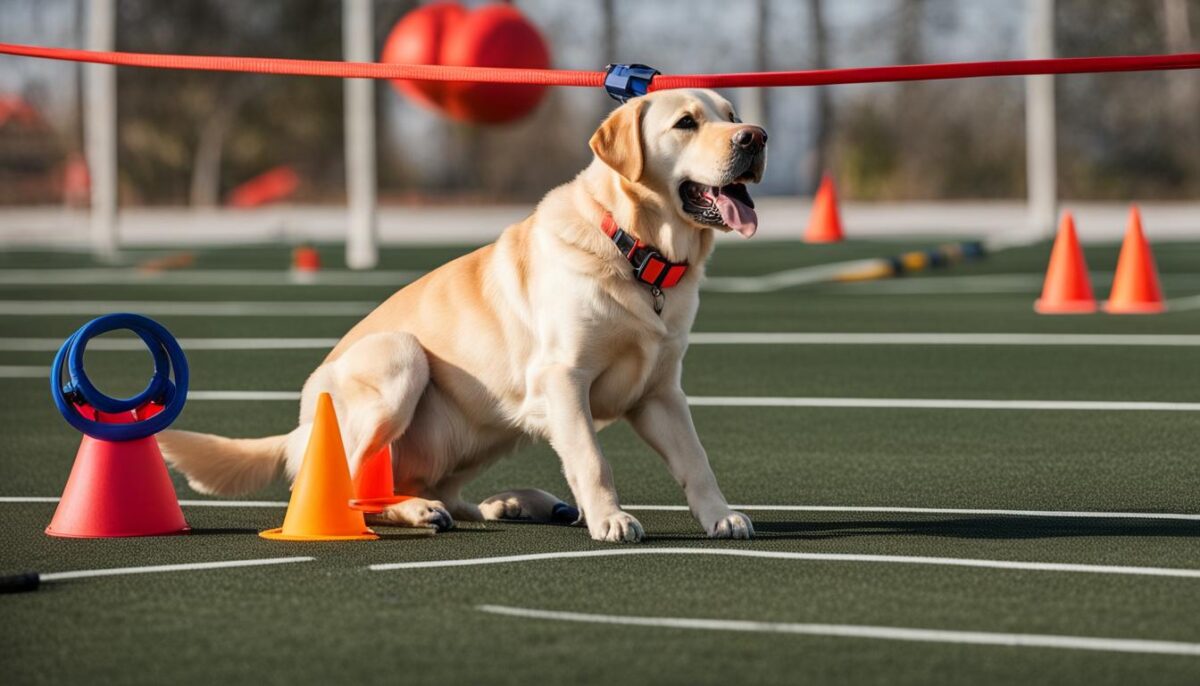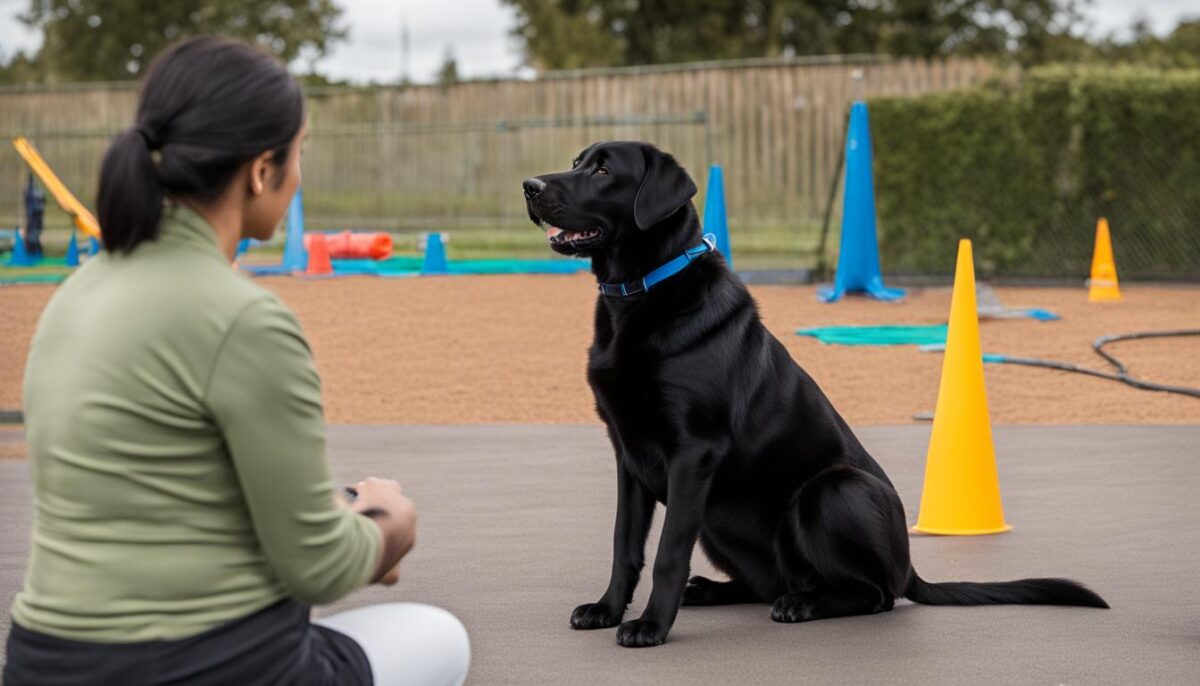Have you just welcomed a fluffy Labrador puppy into your home? Or maybe you’re looking to teach your grown-up Lab some new tricks! Well, you’re in for a treat. Labradors are not only friendly and smart, but they also love to learn. If you’re ready to dive into some fun Labrador training tips, this guide’s for you!
To start, a Lab obedience program will help your puppy know who’s boss (that’s you!). But remember, it’s all about kindness and treats. When you train a Lab puppy, think like a coach—a very friendly coach who has lots of patience and gives out lots of high-fives (or in your Lab’s case, tasty treats).
You’ll see, with some practice, your Lab will be listening to your every word. It’s all about making learning fun. Now let’s get those tails wagging and jump into training!
Key Takeaways
- Create fun times with your Lab by mixing games and learning.
- Little treats make big rewards when your Lab does something good.
- Your Lab needs to run and play. It helps them listen better too!
- Start training early to help your puppy grow into a super smart dog.
- Remember, training is all about being kind, being patient, and having fun!
Understanding Your Labrador’s Unique Traits
Labrador Retrievers are special pups that bring joy to families around the world. Not only are these dogs loved for being friendly, but they also make great helpers for people who need them. They even help people who can’t see to get around! To make your Lab a happy and helpful dog, you should know about their energy, how they like to be with people, and the kind of play and learning they need.
The Popularity and Temperament of Labrador Retrievers
Did you know Labrador Retrievers are one of the most popular dog breeds? It’s because they are so nice to be around. They don’t get mad easily and love to help, which is why they make such good service dogs. Labs are friendly to everyone, even folks they don’t know, which makes them great family pets, too!
Socializing Your Lab for Success
When Labs are young, they need to meet lots of people and visit new places. This helps them learn how to be good at making friends. It’s called socialization. Teach your Lab to play nice with kids and make sure everyone knows to treat your dog with kindness. This kind of learning is as important as any other Lab puppy training.
Physical and Mental Stimulation Needs
Labradors have lots of energy, so they need to play and exercise every day. Take them for walks, throw a ball, or play tug. These activities help them use up their bounce and keep them healthy. They also need to use their brains, so practice games and tricks to give them a good think. This combo of exercise routine and mental stimulation keeps your Lab out of trouble and helps manage their playful side.
- **Exercise:** Going for walks, playing fetch, swimming
- **Learning:** Teaching tricks, playing puzzle games
- **Good Times:** Belly rubs, cuddles, and kind words
Keeping your Lab busy and learning helps grow good behavior reinforcement. It turns their energy into something positive and fun. An exercise routine is not just about keeping your pup in shape, it’s about keeping their mind sharp too. So when you play together, you’re not just having fun, you’re teaching your Lab how to be their best!
| Activity Type | Why It’s Good for Your Lab |
|---|---|
| Physical Play | Burns off energy and keeps them healthy |
| Brain Games | Keeps their mind active and stops naughtiness |
| Friend Time | Teaches social skills and helps them make friends |
Remember, owning a Lab is not just about having a pet; it’s about having a friend that needs love, fun, and smart ways to use their energy. When you understand your Labrador’s unique traits, you can help them live a joyful and helpful life!
Creating a Positive Training Environment
When you train your Labrador, using positive reinforcement is super important. It’s just like when you get a gold star for doing a good job in school. Your Lab feels happy and learns better when they know they’ve done a great job. So, think of treats, extra playtime, and your happy voice as those gold stars for your furry friend.
In a Lab training environment, it’s not just about saying ‘good job’ once. It’s about being consistent. Do you like it when you know exactly what to expect? So does your Labrador. They love knowing that if they sit or stay like you asked, they will get that loving pat or yummy treat. This kind of obedience training is all about being kind and patient.
Let’s break down how to boost the cheer and fun in your training:
- Treats: Always have some yummy treats in your pocket. Giving your Lab a treat right after they do something good tells them, “You did it right!”
- Praise: Use your happiest, most excited voice to tell your Lab they’re awesome. They really care about making you happy.
- Playtime: Sometimes, the best “thank you” is a good, fun game. Toss a ball or play tug-of-war to say “well done.”
Remember, a happy Lab is a well-trained Lab. Keep training joyous, and you’ll have the best buddy in your well-behaved Labrador.
Essential Commands Every Labrador Should Know
Labradors are smart, friendly dogs that love to learn. To live happily with your Lab, you should teach them some basic commands. Effective leash training helps them understand how to walk without pulling, which is called loose leash walking. Good leash manners make walks more fun for you and your dog. With basic obedience commands, your Lab will know how to act nicely.
Training Your Lab to Walk on a Loose Leash
When your Lab walks nicely on a leash, they don’t tug or pull you. This is called loose leash walking. It’s a big part of Lab behavior training. To teach this, use a happy voice and tasty treats. When they walk next to you with a slack leash, say “Good job!” and give them a treat. Keep practicing and they’ll get better and better.
Mastery of the ‘Come’, ‘Drop It’, and ‘Fetch’ Commands
Labs have a natural talent for fetching things. They love playing games like fetch. But first, they need to learn commands like ‘come,’ ‘drop it,’ and ‘fetch.’ To teach ‘come,’ call their name and say “come.” When they come to you, give them a hug or a treat. For ‘drop it,’ offer them a treat in exchange for the ball or toy. ‘Fetch’ is throwing a toy and saying “fetch” as they run to get it. With command mastery, your Lab will know just what to do.
Positively Reinforcing Good Behavior
Positive reinforcement techniques are the best way to train your Lab. When they do something good, give them praise or a treat. That way, they’ll want to do it again. This is part of reward-based training. Always use really small treats so they don’t get too heavy. Big dogs like Labs need to stay fit and strong!
How to Train a Labrador Dog Using Effective Techniques
When you start Labrador Retriever training, it’s like teaching a friend. Labs are super smart and can learn lots of things. It’s important to train your Lab so they know how to behave and can be a great pet. You need to use effective training methods and understand your dog’s behavior for the best results.
Consistency means doing the same things over and over. Make sure you train your dog at the same time each day and use the same words for commands. This helps your dog know what you want. Clear commands are easy for your dog to understand. Use short words like “sit” or “stay” and say them in a kind voice.
One cool thing about Labs is they talk with their body. They might wag their tail to say they are happy or put their ears back if they are unsure. By looking at how they move their tail position, ear movement, and eye contact, you can tell how they feel. This helps you know if they are learning and having fun.
Here’s a list of tips for dog behavior management:
- Always be patient with your Lab.
- Give them treats and praise when they do things right.
- Make sure training is fun so they want to learn.
Check out this table of great training tricks!
| Training Trick | What It Does | How to Do It |
|---|---|---|
| Sit | Teaches your Lab to sit down | Hold a treat above their head and say “sit” |
| Stay | Keeps your Lab in one spot | Ask them to sit, then step back and say “stay” |
| Come | Asks your Lab to come over to you | Back away slowly and call your dog with “come” |
Remember, training your Lab is fun for you and your dog. Keep practicing and stay happy, and your Lab will learn to be a great furry friend!
Caring for a Labrador’s Health and Nutrition During Training
When you are training your active Labradors, it’s important to think about their health and happiness. Let’s make sure your furry friend stays healthy while they learn new tricks!
Monitoring Treat Intake to Prevent Weight Issues
Remember, Labradors love to eat, and they can get overweight if you’re not careful. It’s good to give treats to your dog, but always use treat moderation. Small treats are just as yummy as big ones for your Labrador, and they help with weight management.
Using Activity as a Training Reward
Do you know that instead of treats, you can use games and fun as a reward? Physical exercise makes an excellent reward for your Labrador. You might play fetch or have a little race together. These non-food rewards will keep your pal fit and happy.
Understanding the Impact of Health on Training
Good Labrador health means your dog learns better and is more joyful. If your Lab feels great, they will have more fun learning. Remember to make little training adjustments based on how your dog feels each day, to ensure their well-being.
| Treats for Training | Playtime Activities | How to Check Labrador Health |
|---|---|---|
| Small-sized treats | Fetch with a ball or frisbee | Regular check-ups with the vet |
| Vegetables like carrots | Tug-of-war with a rope toy | Watching for changes in behavior |
| Lots of praise and petting | Hide and seek with their favorite toy | Keeping track of their weight |
Taking care of your Labrador’s health makes training more fun and easy for both of you. Use these tips to make sure your Labrador stays as happy and healthy as they can be!
Conclusion
Your journey with your Labrador is a special one, filled with fun and learning for both of you. Remember, a successful Labrador training journey means taking the time to understand their happy nature and needs. With your care and teaching, your Lab can grow up to be a well-behaved dog. It’s like being a coach and a friend all at once!
From teaching simple commands to making sure they stay healthy and eat right, every step is important. You’re helping them to listen, learn, and become your trusty sidekick. Just like any good team, you and your Labrador will need practice, patience, and lots of love.
So, keep up the good work! With each new day, you’ll see your furry friend become the loyal and loving dog you’ve always wanted. It’s a big task, but together, you can do it. Here’s to a happy life with your smart and cheerful Labrador!
FAQ
Why are Labrador Retrievers considered one of the most popular dog breeds?
Labrador Retrievers are known for their friendly nature and intelligence, making them exceptionally social animals. Their patient temperament often makes them the preferred choice for service dogs and family pets, contributing to their popularity.
What are some effective Labrador training tips?
Some effective Labrador training tips include early socialization to develop good behavior, managing their high energy levels with plenty of exercise, employing positive reinforcement techniques, and focusing on obedience training for command mastery.
How can I train my Lab puppy for good behavior reinforcement?
To reinforce good behavior in your Lab puppy, create a positive training environment with consistent rules, use treats and praise as rewards, and ensure they get enough physical and mental stimulation to prevent boredom-related behaviors.
What type of exercise routine should I establish for my energetic Labrador?
Labradors require at least an hour of exercise daily. Establish a routine involving long walks, fetch, swimming, or any other activities that your Lab enjoys to help them burn off energy and stay physically and mentally stimulated.
How do I implement a successful Lab training environment?
A successful Lab training environment consists of consistency, clear communication, and a positive atmosphere where your dog feels comfortable and motivated to learn. Utilize positive reinforcement, patience, and adaptability to your dog’s learning style.
What are the basic obedience commands every Labrador should know?
Every Labrador should be taught fundamental commands such as ‘sit’, ‘stay’, ‘come’, ‘heel’, ‘drop it’, and ‘fetch’. These commands help with general discipline, managing their retrieving instincts, and ensuring safety during outdoor activities.
Why is loose leash walking important for Labrador Retrievers?
Loose leash walking is important for Labrador Retrievers due to their size and strength. Training your Lab to walk nicely on a leash without pulling can prevent mishaps or behavioral issues during walks and ensure a more enjoyable experience for both the dog and owner.
What is the importance of treat moderation in Lab training?
Treat moderation is critical in Lab training to prevent obesity, as Labradors are prone to weight gain. Using small treats and adjusting meal portions accordingly during training ensures that your Lab stays healthy and at an appropriate weight.
Can physical activities serve as non-food rewards during training?
Yes, physical activities can be effective non-food rewards during training. Labs have high energy needs, and incorporating games like fetch or playtime as a reward satisfies their exercise requirements while reinforcing positive behavior without overfeeding.
How does a Labrador’s health impact its training?
A Labrador’s overall health can significantly affect its ability to learn and respond to training. A well-cared-for Lab with proper nutrition and exercise is more likely to be alert, responsive, and able to participate fully in training sessions.


